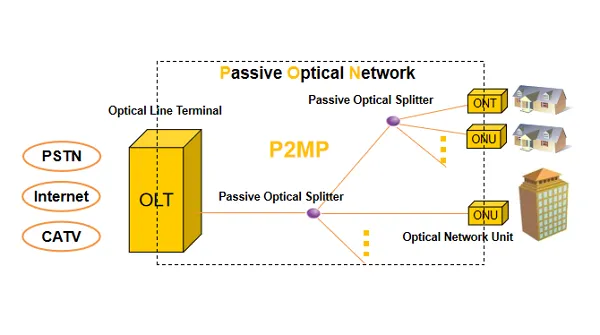Quais são as diferenças entre ONT, OLT e ONU?

Terminal de rede óptica (ONT)
Localização:O ONT está localizado nas instalações do cliente, como casa ou escritório.
Função:Ele serve como ponto final do PON do lado do usuário. O ONT atua como um modem óptico, convertendo sinais ópticos recebidos do OLT em sinais elétricos que podem ser utilizados pelos dispositivos do cliente.
Responsabilidades:
Recebe sinais ópticos do OLT e os converte em sinais elétricos para uso por dispositivos como computadores, telefones e TVs.
Envia dados do usuário upstream para o OLT.
Fornece interfaces para serviços de voz, vídeo e dados ao cliente.
Pode incluir recursos adicionais, como conectividade Wi-Fi, suporte VoIP e recursos de IPTV.
Terminal de linha óptica (OLT)
Localização:A OLT está localizada no escritório central ou data center do provedor de serviços.
Função:Ele serve como ponto final da Rede Óptica Passiva (PON) do lado do ISP. A OLT agrega e gerencia vários Terminais de Rede Óptica (ONTs) e Unidades de Rede Óptica (ONUs) na rede.
Responsabilidades:
Converte sinais elétricos da rede do provedor de serviços em sinais ópticos para transmissão pela rede de fibra óptica.
Gerencia o fluxo de dados tanto upstream (dos usuários para o ISP) quanto downstream (do ISP para os usuários).
Coordena vários sinais analógicos ou digitais em um sinal por meio de multiplexação.
Garante a operação eficiente da rede e gerencia a alocação de largura de banda e a qualidade de serviço para todos os ONTs/ONUs conectados.
Unidade de rede óptica (ONU)
Localização:Semelhante ao ONT, a ONU também está localizada nas instalações do cliente.
Função:Os termos ONU e ONT são frequentemente usados de forma intercambiável, mas pode haver pequenas diferenças com base no contexto e na arquitetura de rede específica.
Responsabilidades:
Assim como o ONT, a ONU converte sinais ópticos do OLT em sinais elétricos para os dispositivos do cliente.
Ele pode atender vários usuários finais em uma unidade multi-residencial (MDU) ou complexo comercial, enquanto um ONT normalmente atende um único usuário ou residência.
Executa funções como modulação de sinal, demodulação e encaminhamento de dados.
Conclusão:
OLT: Dispositivo central no escritório do ISP, gerenciando e agregando múltiplos ONTs/ONUs, convertendo sinais e controlando o fluxo de dados.
ONT: Dispositivo nas instalações do cliente, convertendo sinais ópticos em sinais elétricos, fornecendo interfaces para diversos serviços e conectando usuários individuais à rede.
ONU: Semelhante ao ONT, mas pode atender vários usuários em um ambiente compartilhado, realizando tarefas semelhantes de conversão de sinal e encaminhamento de dados.
Tanto a ONT como a ONU são essenciais para fornecer Internet de alta velocidade e outros serviços através de redes de fibra óptica, enquanto a OLT garante uma gestão eficiente da rede e distribuição de dados.
Horário da postagem: 07/06/2024

